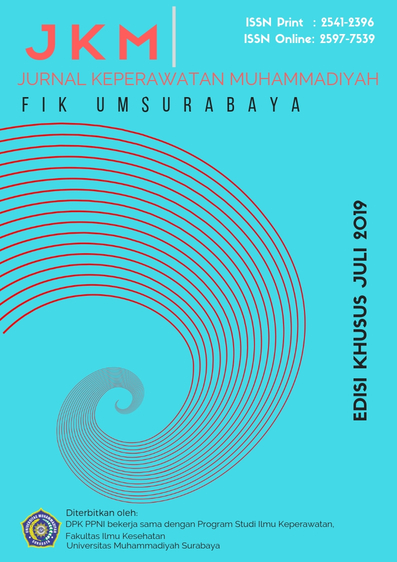Complication of Peripheral IV Catheterization in Neonates: A Systematic Review
DOI:
https://doi.org/10.30651/jkm.v4i2.2667Keywords:
peripheral IV catheterization, complication, neonates, risk factorAbstract
Peripheral intravenous catheterization in neonates often results in complications associated with their condition as vulnerable population. Common complications of IV catheterization include infiltration, extravasation, phlebitis, leakage, or even vascular infection which may lead to death among neonates. Complications of peripheral IV catheterization are still being investigated in studies in order to identify the incidence and risk factors.
Objective: Â Â This systematic review aimed to identify complications of peripheral intravenous catheterization in neonates and its risk factors
Methods: Â Literature searching involved databases such as Science Direct, Scopus, EBSCOhost and SAGE Journals for articles published between 2009-2018 with key words of peripheral intravenous; complication; phlebitis; neonates; risk factor; and infusion therapy.
Results: 7 articles addressing peripheral IV catheterization in neonates were included in analysis, revealing three most frequent complications include infiltration, extravasation, and phlebitis. Various factors may affect it.
Conclusion:  Complication incidence (more than 60%) suggested that the phenomenon is an issue that should be immediately addressed since neonates are part of vulnerable population. It is imperative to continue investigating further in order to identify the incidence and factors affecting itReferences
Beall, V., Hall, B., Mulholland, J. T., & Gephart, S. M. (2013). Neonatal extravasation: An overview and algorithm for evidence-based treatment. Newborn and Infant Nursing Reviews, 13(4), 189–195. https://doi.org/10.1053/j.nainr.2013.09.001
Birhane, E., Kidanu, K., Kassa, M., Gerezgiher, D., Tsegay, L., Weldu, B., … Gerensea, H. (2017). Lifespan and associated factors of peripheral intravenous Cannula among infants admitted in public hospitals of Mekelle City, Tigray, Ethiopia, 2016. BMC Nursing, 16(1), 1–8. https://doi.org/10.1186/s12912-017-0227-1
Danski, M. T. R., Mingorance, P., Johann, D. A., Vayego, S. A., & Lind, J. (2016). Incidence of local complications and risk factors associated with peripheral intravenous catheter in neonates. Revista Da Escola de Enfermagem, 50(1), 22–28. https://doi.org/10.1590/S0080-623420160000100003
Legemaat, M., Carr, P. J., Van Rens, R. M., Van Dijk, M., Poslawsky, I. E., & Van den Hoogen, A. (2016). Peripheral intravenous cannulation: Complication rates in the neonatal population: A multicenter observational study. Journal of Vascular Access, 17(4), 360–365. https://doi.org/10.5301/jva.5000558
Ramasethu, J. (2008). Complications of vascular catheters in the neonatal intensive care unit. Clinics in Perinatology, 35(1), 199–222. https://doi.org/10.1016/j.clp.2007.11.007
Rickard, C. M., Webster, J., Wallis, M. C., Marsh, N., McGrail, M. R., French, V., … Whitby, M. (2012). Routine versus clinically indicated replacement of peripheral intravenous catheters: a randomised controlled equivalence trial. The Lancet, 380(9847), 1066–1074. doi:10.1016/s0140-6736(12)61082-4
Serane, T., & Kothendaraman, B. (2015). Incidence and risk factors of infections associated with peripheral intravenous catheters. Journal of Infection Prevention, 17(3), 115–120. https://doi.org/10.1177/1757177416631415
Stok, D., & Wieringa, J. W. (2016). Continuous infusion versus intermittent flushing: Maintaining peripheral intravenous access in newborn infants. Journal of Perinatology, 36(10), 870–873. https://doi.org/10.1038/jp.2016.94
Tsai, M.-H., Chu, S.-M., Lien, R., Huang, H.-R., Wang, J.-W., Chiang, C.-C., … Huang, Y.-C. (2011). Complications Associated with 2 Different Types of Percutaneously Inserted Central Venous Catheters in Very Low Birth Weight Infants. Infection Control & Hospital Epidemiology, 32(03), 258–266. https://doi.org/10.1086/658335
Unbeck, M., Förberg, U., Ygge, B. M., Ehrenberg, A., & Petzold, M. (2015). Peripheral venous catheter related complications are common among paediatric and neonatal patients. Acta Paediatrica, International Journal of Paediatrics, 104(6), 566–574. https://doi.org/10.1111/apa.12963
Van Haltren, K., Malhotra, A., Walsh, T. A., Chin, L. Y., Davies-Tuck, M., & Hayden, L. (2018). Elective replacement of intravenous cannula in neonates—a randomised trial. European Journal of Pediatrics, 177(11), 1719–1726. https://doi.org/10.1007/s00431-018-3234-7
Downloads
Published
Issue
Section
License
- Penulis tetap memegang hak atas karyanya dan memberikan hak publikasi pertama kepada jurnal ini yang secara simultan karya tersebut dilisensikan di bawah:Â Creative Commons Attribution-ShareAlike 4.0 International (CC BY-SA 4.0)













